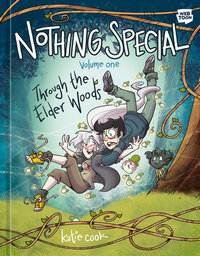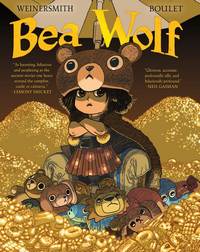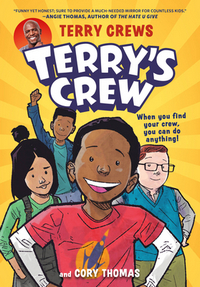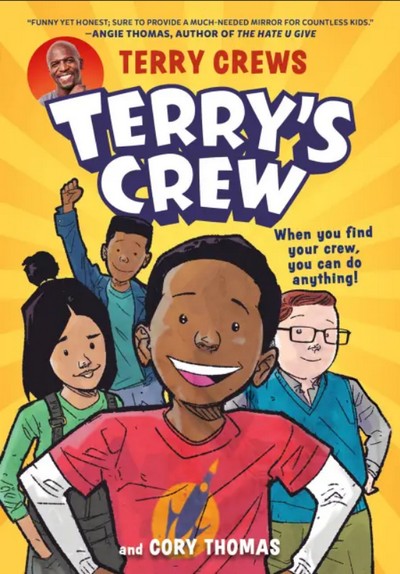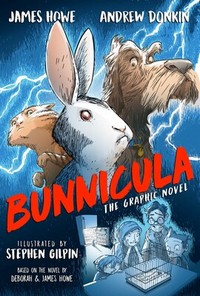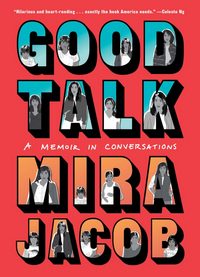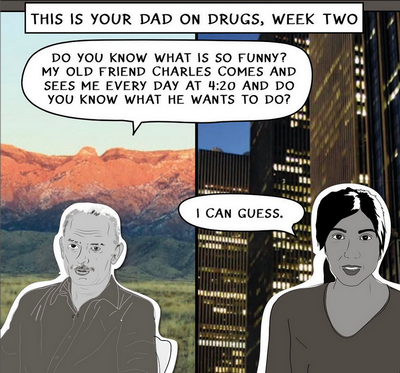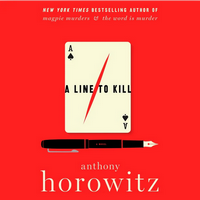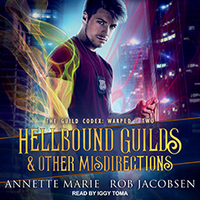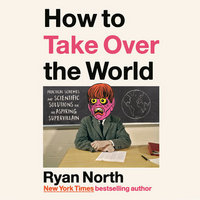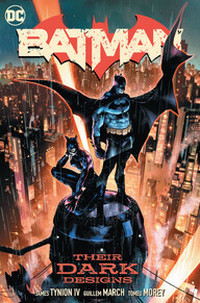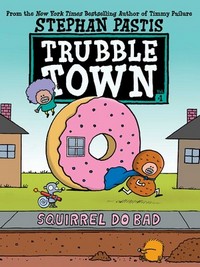Be sure to check out the rest of the highlights, reviews, and other posts associated with the Tour here.
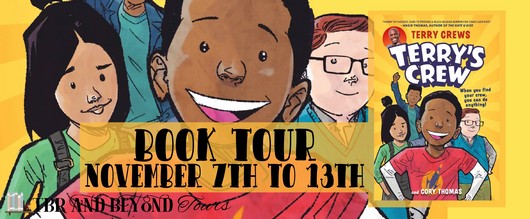
by Terry Crews, Cory Thomas (Illustrator)
DETAILS:
Publisher: Little, Brown Books for Young Readers
Publication Date: November 8, 2022
Format: eBook
Length: 208 pg.
Read Date: November 4, 2022

What’s Terry’s Crew About?
Our protagonist, Terry, is a bright, energetic (very energetic) kid with big dreams. Huge dreams. He even has a name for them, and when he speaks, you can hear the capitalization—Big Dream Plan.* He is basically the living embodiment of joie de vivre. We meet him the day before he starts a new Middle School on the other side of town—he’s qualified for a scholarship and his parents are hoping this is his ticket to a better life.
* Yes, this is a graphic novel, so you can literally see the capitals, but those around him hear the capitals.
Not that there’s anything wrong with the life he has—demanding, strict, but caring and supportive parents. An older brother who always has his back (although he’s human and stumbles), who has the same hopes for Terry that he does. He even has a small-time criminal from the neighborhood looking out for him. It’s a good life, but his parents still hope that his talents and ambitions can give him a better (read: financially secure and in a better neighborhood).
Okay, that’s more space than I thought the introduction was going to take, let’s get moving. His new school is dazzling—there’s clearly money being spent on all levels here. And most of the students come from it, too. It seems to take Terry a while to figure that out, and when he does, it doesn’t seem to phase him.
Terry has a hard time making friends at first but is given a chance to get in with the “in crowd” (I’m sure no one says that anymore, but I’m not going to try to pretend I know what people say), by bullying a kid. It goes well enough, but he feels horrible about it and tries to make things right the next day. This leads to Terry landing a small group of potential friends (including the kid he bullied) and puts him firmly in the “out-crowd.”
An extra-curricular group activity proves the perfect outlet for Terry’s creativity (which needs a large outlet, the kid cannot stop creating), but it seems to be damaging his grades. His mother puts an end to that—which causes some family tension and forces Terry to be even more creative in his approach to the extra-curricular activity.
Things go on from there—basically, this is about Terry getting his feet wet in a new world of opportunity, learning how to navigate it, making some real friends, and learning to appreciate the support and direction of his parents.
The Tone of the Book
Terry’s pretty naïve—or at least he comes across that way. He’s so caught up in his dreams and the possibilities of the future that he really doesn’t seem to notice or understand the harsher realities around him. His big brother does a good job of helping him navigate through this without opening his eyes.
This gives the whole book a similarly hopeful and almost starry-eyed tone and feel. But the art is thoughtfully used to make sure the reader sees the reality—the looks on the faces of characters around him, the changes in the economic status of his environments, the run-down nature of his neighborhood’s buildings, and so on. Terry’s eyes are on the bright future, but he’s living in a very real now, and the art serves well to show that both of these things are true.
It feels like I’ve already transitioned out of this section into the next, let’s make it official:
A Word About the Art
Cory Thomas is a huge part of what makes this graphic novel work. From his capturing the dual worlds that Terry lives into his character designs and the sense of energy conveyed on the page, Thomas really brought this to life.
As usual, I struggle to describe the artwork, so forgive me if any of the positive things I’m trying to say here don’t sound positive.
Thomas’s artwork isn’t polished and full of fine detail—these aren’t beautiful panels like you’d get from George Pérez or someone in his school. The penciling and inking are rough, the lines are jagged—they convey an energy, a youth, and a vitality more like Bill Watterson (and the more I think of it, the more I like my floundering here landed on Watterson as a comparison).
The expressions on the character’s faces alone make me want to commend his artwork here, from Terry’s almost ever-present smile (in various wattages) to the doubt or cynicism depicted on others, these characters pop off the page.
So, what did I think about Terry’s Crew?
In interviews (and in many of his performances), Terry Crews comes across as someone with an indefatigable optimism, an infectious enthusiasm, and a near-unrelenting positivity. I get the impression that this is a fully intentional outlook on his part and I can’t help but admire it. This book encapsulates that outlook and brings it to life in this fictional Terry.
Yes, I wondered if the book ends up being a little Pollyanna-ish in the end, but I think that was the goal—and who doesn’t need a little sunshine? I had a lot of fun reading this—I think it’s difficult not to. Terry, his friends, family, and others (including the nefarious neighborhood supporter) show that with support, encouragement, and teamwork, small dreams can come true—with the assurance that comes from that. If you can make enough of those small dreams come true, even a Big Dream Plan is possible.
This worked for me, someone decades past the target audience, I’d like to think—and I hope—that this will bring some encouragement into the lives of the Middle-Grade audience, too. I recommend picking this up and putting it in the hands of the Middle Grade (maybe even younger) reader in your life.


About the Book:
Actor-author-athlete Terry Crews digs into his childhood in Flint, Michigan, to tell a story of fitting in and finding your place in his showstopping debut middle-grade graphic novel, the start of a series.
Young Terry Crews has a Big Dream Plan: He wants to become a MULTIHYPHENATE. That means he wants to be an artist. And a football player. And a musician. And maybe a NASA scientist, too! OK, maybe it’s ambitious, but his parents worked hard so he could go to a new school—Rock City Academy, a prestigious institution (read: rich kids go there) where he’s sure he can make his mark at the talent show. He plans an elaborate performance with his new friends, Rani, a passionate engineer, and Xander, a shy kid with a head like an encyclopedia.
Along the way, Terry’s plan is threatened by his grades, which slip below Mom-and-Dad-approved levels, as well as the schemes of the school’s football star, Rick, who won’t stop until Terry quits the talent show altogether. No matter what challenges he faces, though, Terry knows that he always has his crew to back him up.
Purchase Links
Goodreads ~ Amazon ~ Barnes & Noble ~ Book Depository ~ Indigo ~ IndieBound

About the Author:
Terry Alan Crews (born July 30, 1968) is an American actor and former American football player. He is best known for playing Julius on the UPN/CW sitcom Everybody Hates Chris, Sergeant Terry Jeffords on the NBC comedy Brooklyn Nine-Nine, and for his appearances in Old Spice commercials, as well as films such as Friday After Next, Idiocracy, and The Expendables series. He is a host of America’s Got Talent.
Author Links
Twitter ~ Instagram ~ Goodreads ~ Facebook

My thanks to TBR and Beyond Tours for the invitation to participate in this Book Tour and the materials (including the book) they provided.
 Concerning Wings
Concerning Wings

![]()







